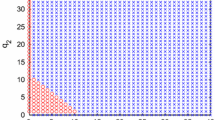Abstract
We consider a discrete-time admission control problem in a company operating in service industries with two classes of customers. For the first class of customers, the company then (1) has an option to accept or reject him/her (admission control), or (2) decides on an offering price (pricing control). The second-class (sideline) customers are only served if no first-class customers are in the system, and this yields the sideline profit. In this paper, we discuss both admission control and pricing control problems within an identical framework, and we examine the properties of the optimal policies to maximize the total expected present discounted net profits. We show that when the sideline profit is large, the optimal policies may not be monotone in the number of first-class customers in the system.
Similar content being viewed by others
References
Crabill, S.B., Gross, D., Magazine, M.: A classified bibliography of research on optimal design and control of queues. Oper. Res. 25(2), 219–232 (1997)
Dewan, S., Mendelson, H.: User delay costs and internal pricing for a service facility. Manage. Sci. 36(12), 1502–1517 (1990)
Gans, N., Savin, S.: Pricing and capacity rationing in rentals. Working Paper, Wharton School of Business, University of Pennsylvania (2005)
Heyman, D.P.: Optimal operating policies for M/G/1 queueing systems. Oper. Res. 16, 362–382 (1968)
Ikuta, S.: Optimal stopping problem with uncertain recall. J. Oper. Res. Soc. Jpn. 31(2), 145–170 (1988)
Ikuta, S.: An integration of the optimal stopping problem and the optimal pricing problem—model with no recall. Discussion paper No. 1084, Institute of Policy and Planning Sciences, University of Tsukuba (2004)
Johansen, S.G.: Optimal prices of an M/G/1 job shop. Oper. Res. 42, 765–774 (1994)
Kang, B.K.: Optimal stopping problem with recall cost. Eur. J. Oper. Res. 117, 222–238 (1999)
Koole, G.: Structural results for the control of queueing systems using event-based dynamic programming. Queueing Syst. 30, 323–339 (1998)
Kuri, J., Kumar, A.: Optimal control of arrivals of queues with delayed queue length information. IEEE Trans. Automat. Contr. 40(8), 1444–1450 (1995)
Lin, K.Y., Ross, S.M.: Optimal admission control for a single-server loss queue. J. Appl. Probab. 41(2), 535–546 (2004)
Lippman, S.A.: Applying a new device in the optimization of exponential queueing systems. Oper. Res. 23, 687–710 (1975)
Lippman, S.A., Ross, S.M.: The streetwalker’s dilemma: a job shop model. SIAM J. Appl. Math. 20(3), 336–342 (1971)
Low, D.W.: Optimal dynamic pricing policies for an M/M/s queue. Oper. Res. 22(3), 545–561 (1974)
Mendelson, H.: Pricing computer services: queueing effects. Commun. ACM 28, 312–321 (1985)
Miller, M.: A queueing reward system with several customer classes. Manage. Sci. 16(3), 234–245 (1969)
Örmeci, E.L., Burnetas, A.: Dynamic admission control for loss systems with batch arrivals. Adv. Appl. Probab. 37(4), 915–937 (2005)
Paschalidis, I.C., Tsitsiklis, J.N.: Congestion-dependent pricing of network services. IEEE/ACM Trans. Netw. 8, 171–184 (2000)
Ross, S.M.: Introduction to Stochastic Dynamic Programming. Academic Press, San Diego (1983)
Saito, T.: Optimal stopping problem with controlled recall. Probab. Eng. Inf. Sci. 12, 91–108 (1998)
Son, J.D., Ikuta, S.: Customer selection problem with search cost, due date, sideline profit, and no waiting room. Asia-Pac. J. Oper. Res. 24(5), 647–666 (2007)
Stidham, S.: Optimal control of admission to a queueing system. IEEE Trans. Automat. Contr. 30(8), 705–713 (1985)
Stidham, S.: Pricing and capacity decisions for a service facility: stability and multiple local optima. Manage. Sci. 38(8), 1121–1139 (1992)
Stidham, S., Weber, R.: A survey of Markov decision models for control of networks of queues. Queueing Syst. 13, 291–314 (1993)
Yoon, S.H., Lewis, M.E.: Optimal pricing and admission control in a queueing system with periodically varying parameters. Queueing Syst. 47(3), 177–199 (2004)
You, P.S.: Sequential buying policies. Eur. J. Oper. Res. 120, 535–544 (2000)
Ziya, S., Ayhan, H., Foley, R.D.: Optimal pricing for a service facility. Technical Report UNC/STOR/04/03, Department of Statistics and Operations Research, University of North Carolina (2004)
Author information
Authors and Affiliations
Corresponding author
Additional information
This work was supported by the Soongsil University Research Fund.
Rights and permissions
About this article
Cite this article
Son, JD. Optimal admission and pricing control problem with deterministic service times and sideline profit. Queueing Syst 60, 71–85 (2008). https://doi.org/10.1007/s11134-008-9087-4
Received:
Revised:
Published:
Issue Date:
DOI: https://doi.org/10.1007/s11134-008-9087-4




